This article was co-authored by wikiHow Staff. Our trained team of editors and researchers validate articles for accuracy and comprehensiveness. wikiHow's Content Management Team carefully monitors the work from our editorial staff to ensure that each article is backed by trusted research and meets our high quality standards.
wikiHow marks an article as reader-approved once it receives enough positive feedback. This article received 11 testimonials and 98% of readers who voted found it helpful, earning it our reader-approved status.
This article has been viewed 213,165 times.
Learn more...
Whether you're reading for devotional, cultural, or personal reasons, a year is a reasonable amount of time in which to read the Bible. Before you begin, take some time to consider how you would like to approach your task. You can read alone, or in a group. You can read one translation of the Bible, or several. You can read the Bible with or without commentary or context. Pace yourself, and track your progress.
Steps
Choosing How to Read
-
1Time yourself. To get through a long text without losing focus, try reading your bible for a regular amount of time every day. You might read for twenty minutes to an hour, depending on your reading speed and attention span. If there is a time of your day when you can count on having a certain amount of quiet time, read then.
- Keep a calendar and track your progress. Tick a box every day you do your reading.
- If you have an average reading speed and you read for about ten minutes a day for a year, you should finish with time to spare. To be able to take off some days and spend extra time on dense passages, try reading for at least twenty minutes at a time.
-
2Count your pages. Take the number of pages in your edition of the Bible, and divide it by 365. Then, read that number of pages every day. For example, if your edition of the Bible has 1,760 pages, that's 4.8 pages a day. Round up and read 5 pages a day. Check your progress every month to make sure you've made your monthly page count.
- If dividing your reading up by day doesn't work, because you have a changeable schedule, try setting weekly or monthly reading goals.
Advertisement -
3Read with others. You might find it easier to meet your reading goals and boost your comprehension if you have company. Join an existing reading group, or form your own. If you attend a church, an interfaith organization, or a secular organization such as an anarchist free school, propose a reading group and decide on a pace, order, and meeting schedule that suits your group. Members of your group can read together in a room, or read separately and come together for monthly meetings.
- Alternatively, ask a friend or family member to read along with you. Even a long distance friend can be a good reading buddy—set reading goals together, and make a weekly discussion date online, in person, or over the phone.
- Take a class. Search online, or at your local community college, church, or free school, for Bible study classes. Taking a course that requires you to read the whole Bible will motivate you to read, while providing valuable historical context.
-
4Read in a way that commands your focus. Taking in a text is very different from skimming. Choose to read in a way that lets you really absorb the words in front of you. Reading aloud can help you retain what you read.[1] Rereading can also be helpful.
- If you are a morning person, read in the morning. If you focus better at night, read then.
- If you find your mind wandering, try reading in sections. For instance, read for twenty minutes, stand up and have a glass of water, then read for another twenty.
-
5Listen to an audio Bible. If you have trouble comprehending reading, or would just like to hear the Bible while you do your daily chores or exercises, download a recording of someone reading it. If you search online, you can even find audiobooks that are designed to be listened to over an entire year.
- Even if you are also reading the Bible, you might consider listening as well. If you are reading one translation you might choose to listen to a different translation, for example.
-
6Sign up for an online Bible email service. You can sign up for a plan that emails you your daily readings. If you have trouble picking up a book regularly, but are very prompt with emails, you can motivate yourself by marking your Bible email "read" each day.
-
7Read with prayer. If you are reading for purposes of devotion, include your reading in your daily faith routine.[2] Pray before or after you read. Read purposefully, as if you were praying. Ask for guidance in your reading. Read with a question in mind, or read blindly and allow your mind to absorb the wisdom of the words.
Choosing an Order of Reading
-
1Read the Bible from start to finish. Pick up your Bible as if it were a novel, and read it from Genesis to Revelations.[3] This choice might be good for you if you believe in "canonical order," an order ordained by God. It might also be a good choice if looking up verse numbers or chapters slows you down. In that case, ignore the numbers and start reading from the first page.
- You can even purchase versions of the Bible that contains no verse numbers, if you choose.
-
2Read in chronological order. You can read the Bible in the order in which its events occurred. Look online for reading plans that lay out the order of events in the Bible.[4] If you read chronologically, you will break up the different books. For example, you will find yourself switching to the Book of Job in the middle of reading Genesis, because Job lived during the time covered in Genesis.[5]
-
3Read in historical order. Read the books of the Bible according to estimates of when they were written. If you are interested in tracking the ways different writers of the Bible responded to, and revised, one another's thinking, you might choose to read in this order. Find lists of estimated dates online.[6]
Reading the Bible from Start to Finish
-
1Read every day, beginning in January. One method of reading the Bible is to do it every day, beginning in January. If you would like to begin in another month, adjust your schedule accordingly.
-
2Read Genesis and Exodus in January. Genesis and Exodus are part of the Pentateuch (the first 5 books of the Bible) and are known as books of the law because they provide laws and instructions for the people of Israel.
- Read 3 chapters each day. At this rate, you will complete the book of Genesis on Jan. 17 and the book of Exodus on Jan. 31.
- If you would like to use this schedule but do not plan to begin in January, adjust your monthly plan accordingly.
-
3Read Leviticus and Numbers in February, and start the book of Deuteronomy. The readings this month focus on the books of the law. Continue to read an average of 3 chapters each day. Chapter length varies.
- Read 4 chapters on Feb. 1; 3 chapters each day from Feb. 2-4; 2 chapters on Feb. 5; 3 chapters each day from Feb. 6-7; 2 chapters each day from Feb. 8-13; and 1 chapter on Feb. 14.
- Read 3 chapters each day from Feb. 15-16; 2 chapters each day from Feb. 17-18; 3 chapters on Feb. 19; 2 chapters on Feb. 20; 3 chapters on Feb. 21; 2 chapters on Feb. 22; 3 chapters on Feb. 23; and 2 chapters each day from Feb. 24-28.
- Using this reading plan, you will complete Leviticus on Feb. 10 and will finish Numbers on Feb. 26. On the last day of February, you will have completed Deuteronomy 4 (the fourth chapter of Deuteronomy).
-
4Read the rest of Deuteronomy, Joshua, Judges, Ruth and part of 1 Samuel in March. The book of Deuteronomy will conclude the books of the law. The other books for this month are considered historical books, which share the history of God's people in the Old Testament.
- Start with chapter 5 of Deuteronomy. Read 3 chapters each day from March 1-4. Read 4 chapters on March 5; 3 chapters on March 6; 4 chapters on March 7; 2 chapters each day from March 8-9 and 3 chapters on March 10.
- Read 4 chapters each day from March 11-12; 3 chapters on March 13 and 4 chapters on March 14; 3 chapters each day from March 15-17; 2 chapters on March 18; 3 chapters on March 19; 2 chapters each day from March 20-21.
- Read 3 chapters each day from March 22-25; 4 chapters on March 26; 3 chapters on March 27; 5 chapters on March 28; 4 chapters on March 29; 2 chapters on March 30; and 3 chapters on March 31.
- If you follow this plan, you will complete Deuteronomy on March 10, Joshua on March 17, Judges on March 25 and Ruth on March 26. You also will complete the first 17 chapters of 1 Samuel, which is more than halfway through the book.
-
5Complete 1 Samuel, 2 Samuel, 1 Kings and 2 Kings in April. These books are classified as historical Old Testament books.
- Read 3 chapters on April 1, beginning with 1 Samuel 18. Read 4 chapters on April 2; 3 chapters on April 3; 4 chapters on April 4; 3 chapters on April 5; 4 chapters on April 6; 5 chapters on April 7 and 3 chapters each day from April 8-11.
- Read 2 chapters on April 12; 3 chapters on April 13; 2 chapters each day from April 14-16; 3 chapters each day from April 17-19 and 2 chapters on April 20.
- Read 3 chapters on April 21; 2 chapters on April 22; 3 chapters each day from April 23-26; 2 chapters on April 27; 3 chapters each day from April 28-29; and 2 chapters on April 30.
- By following this plan, you will complete 1 Samuel on April 4, 2 Samuel on April 11, 1 Kings on April 20 and 2 Kings on April 29. On the last day of the month, you will begin the book of 1 Chronicles.
-
6Read 1 Chronicles, 2 Chronicles, Ezra, Nehemiah and Esther in May. These books conclude the historical books of the Old Testament.
- Begin the May reading with the third chapter of 1 Chronicles. Read 3 chapters on May 1; 1 chapter on May 2; 2 chapters on May 3; 3 chapters each day from May 4-6; 4 chapters on May 7 and 3 chapters each day from May 8-10.
- Read 4 chapters on May 11; 3 chapters on May 12; 4 chapters on May 13; 5 chapters on May 14; 3 chapters on May 15; 4 chapters on May 16; 3 chapters on May 17; 4 chapters on May 18; 3 chapters on May 19 and 2 chapters on May 20.
- Read 3 chapters on May 21; 4 chapters on May 22; 3 chapters each day from May 23-25; 1 chapter on May 26; 2 chapters each day from May 27-29; and 5 chapters each day from May 30-31.
- This reading plan will enable you to finish 1 Chronicles on May 10, 2 Chronicles on May 20, Ezra on May 23, Nehemiah on May 29 and Esther on May 31.
-
7Read Job and part of Psalm in June. These books are classified as poetic books of the Old Testament.
- Start with chapter 1 in the book of Job. Read 4 chapters on June 1; 3 chapters each day from June 2-5; 4 chapters on June 6; 3 chapters on June 7; 5 chapters on June 8 and 3 chapters each day from June 9-11.
- Read 2 chapters on June 12; 3 chapters on June 13; 8 chapters each day from June 14-15; 4 chapters on June 16; 5 chapters on June 17; 6 chapters on June 18 and 4 chapters each day from June 19-20.
- Read 6 chapters on June 21; 5 chapters on June 22; 7 chapters on June 23; 8 chapters on June 24; 4 chapters each day from June 25-27; 2 chapters on June 28; 6 chapters on June 29; and 4 chapters on June 30.
- With this reading plan, you will complete the book of Job on June 13 and get more than halfway through the book of Psalm.
-
8Read Psalm, Proverbs, Ecclesiastes, Song of Solomon and part of Isaiah in July. Psalm, Proverbs, Ecclesiastes and Song of Solomon are considered poetic books of the Old Testament.
- Begin with Psalm 90. Read 6 chapters on July 1; 7 chapters on July 2; 3 chapters on July 3; 2 chapters on July 4; 7 chapters on July 5; 4 chapters on July 6; 1 chapter split between July 7- 8 (this is Psalm 119, which is a long chapter); 13 chapters on July 9 and 7 chapters on July 10.
- Read 6 chapters on July 11; 5 chapters on July 12; 3 chapters each day from July 13-19 and 2 chapters on July 20.
- Read 3 chapters each day from July 21-22; 2 chapters on July 23; 4 chapters each day from July 24-26; 8 chapters on July 27; and 4 chapters each day from July 28-31.
- Using this reading schedule, you will finish Psalm on July 12, Proverbs on July 23, Ecclesiastes on July 26 and Song of Solomon on July 27. The last 4 days of the month will be spent reading the first 17 chapters of Isaiah.
-
9Complete the books of Isaiah, Jeremiah and Lamentations during August. These books are classified as Major Prophets, and share the stories and warnings from the prophets of Israel.
- Begin the August reading with Isaiah 18. Read 5 chapters each day from Aug. 1-2; 3 chapters on Aug. 3; 5 chapters on Aug. 4; 6 chapters on Aug. 5; 3 chapters on Aug. 6 and 5 chapters each day from Aug. 7-10.
- Read 3 chapters each day from Aug. 11-14; 4 chapters each day from Aug. 15-16; 5 chapters on Aug. 17; 3 chapters on Aug. 18; 4 chapters on Aug. 19 and 2 chapters on Aug. 20.
- Read 3 chapters each day from Aug. 21-22; 4 chapters each day from Aug. 23-24; 3 chapters on Aug. 25; 2 chapters each day from Aug. 26-27; 3 chapters on Aug. 28; 2 chapters on Aug. 29; and 4 chapters each day from Aug. 30-31.
- With this reading plan, you will complete Isaiah on Aug. 11, Jeremiah on Aug. 27 and Lamentations on Aug. 29. During the last 2 days of the month, you will begin the book of Ezekiel.
-
10Read Ezekiel, Daniel, Hosea, Joel, Amos, Obadiah, Jonah, Micah, Nahum, Habakkuk, Zephaniah, Haggai and Zechariah in September. The books of Ezekiel and Daniel are considered Major Prophet writings, while the remainder of the books for this month are classified as Minor Prophet writings. The reading plan may appear to be a lot of material for one month, but many of the books are short, with only a few chapters each.
- Start with chapter 9 in the book of Ezekiel. Read 4 chapters on Sept. 1; 3 chapters on Sept. 2; 2 chapters on Sept. 3; 3 chapters on Sept. 4; 2 chapters each day from Sept. 5-6 and 3 chapters each day from Sept. 7-18.
- Read 7 chapters on Sept. 19-20; 3 chapters on Sept. 21; 5 chapters on Sept. 22; 4 chapters on Sept. 23; 5 chapters on Sept. 24; 7 chapters on Sept. 25; 3 chapters on Sept. 26; 6 chapters on Sept. 27; 2 chapters on Sept. 28; and 7 chapters each day from Sept. 29-30.
- This reading plan enables you to finish Ezekiel on Sept. 14, Daniel on Sept. 18, Hosea on Sept. 20, Joel on Sept. 21, Amos on Sept. 23, Obadiah and Jonah on Sept. 24, Micah on Sept. 25, Nahum on Sept. 26, Habakkuk and Zephaniah on Sept. 27, Haggai on Sept. 28 and Zechariah on Sept. 30.
-
11Read Malachi, Matthew, Mark and most of Luke in October. Malachi is the last book of the Old Testament, so you will complete the Old Testament and begin the New Testament if you follow the reading plan this month. You also will begin the chapters known as the gospels in the New Testament.
- Begin with Malachi 1. Read 4 chapters each day from Oct. 1-2; 2 chapters each day from Oct. 3-7; 3 chapters on Oct. 8; 2 chapters each day from Oct. 9-12; 1 chapter on Oct. 13; 2 chapters on Oct. 14 and 3 chapters on Oct. 15.
- Read 2 chapters each day from Oct. 16-20; 1 chapter on Oct. 21; 2 chapters on Oct. 22; 1 chapter on Oct. 23; 2 chapters each day from Oct. 24-29; 3 chapters on Oct. 30; and 2 chapters on Oct. 31.
- If you stick to this reading plan, you will complete Malachi on Oct. 1, Matthew on Oct 14 and Mark on Oct. 22.
-
12Complete Luke, John, Acts and Romans and begin 1 Corinthians in November. During this month, you will finish the gospels and learn about New Testament history through the book of Acts. You also will begin the epistles, which are letters written to specific communities.
- Start this month's reading with Luke 19. Read 2 chapters each day from Nov. 1-9; 3 chapters each day from Nov. 10-15.
- Read 2 chapters on Nov. 16; 3 chapters on Nov. 17; 2 chapters each day from Nov. 18-19; 3 chapters each day from Nov. 20-24; 4 chapters on Nov. 25; 3 chapters each day from Nov. 26-28; and 4 chapters each day from Nov. 29-30.
- Using this reading schedule, you will complete Luke on Nov. 3, John on Nov. 12, Acts on Nov. 23 and Romans on Nov. 28.
-
13Finish the Bible in December. The books for this month include 1 Corinthians, 2 Corinthians, Galatians, Ephesians, Philippians, Colossians, 1 Thessalonians, 2 Thessalonians, 1 Timothy, 2 Timothy, Titus, Philemon, Hebrews, James, 1 Peter, 2 Peter, 1 John, 2 John, 3 John, Jude and Revelation. These books are categorized as epistles, except for Revelation, which is typically considered a book of prophecy. This month's reading assignment may appear lengthy based on the number of books, but many of the books are short and some contain only one chapter.
- Begin with 1 Corinthians 9. Read 3 chapters each day from Dec. 1-2; 2 chapters on Dec. 3; 4 chapters on Dec. 4; 5 chapters on Dec. 5; 4 chapters on Dec. 6 and 3 chapters each day from Dec. 7-10.
- Read 4 chapters on Dec. 11; 4 chapters on Dec. 12; 5 chapters on Dec. 13; 3 chapters on Dec. 14; 6 chapters on Dec. 15; 4 chapters each day from Dec. 16-17; 6 chapters on Dec. 18; 4 chapters on Dec. 19 and 3 chapters on Dec. 20.
- Read 5 chapters on Dec. 21; 5 chapters on Dec. 22; 3 chapters on Dec. 23; 5 chapters on Dec. 24; 3 chapters on Dec. 25; 3 chapters on Dec. 26; 5 chapters on Dec. 27; 4 chapters each day from Dec. 28-29; and 3 chapters each day from Dec. 30-31.
- Using this reading plan, you will finish 1 Corinthians on Dec. 3, 2 Corinthians on Dec. 6, Galatians on Dec. 8, Ephesians on Dec. 10, Philippians on Dec. 11, Colossians on Dec. 12, 1 Thessalonians on Dec. 13, 2 Thessalonians on Dec. 14, 1 Timothy on Dec. 15, 2 Timothy on Dec. 16, Titus and Philemon on Dec. 17, Hebrews on Dec. 20, James on Dec. 21, 1 Peter on Dec. 22, 2 Peter on Dec. 23, 1 John on Dec. 24, 2 John, 3 John and Jude on Dec. 25, and Revelation on Dec. 31.
- Most importantly, you will have completed the entire Bible from beginning to end in one year.
Community Q&A
-
QuestionHow many chapters would I have to read every day to read the Bible in a year?
 Community AnswerThere are close to 929 chapters in the Old Testament and 260 chapters in the New Testament. This would mean that you would need to read around 3 - 4 chapters per day to read the complete Christian Bible.
Community AnswerThere are close to 929 chapters in the Old Testament and 260 chapters in the New Testament. This would mean that you would need to read around 3 - 4 chapters per day to read the complete Christian Bible. -
QuestionIs it okay if I can't study in a quiet place?
 Community AnswerThere are no rules about where you must study. As long as you can concentrate on what you're reading and absorb the material, it's absolutely fine.
Community AnswerThere are no rules about where you must study. As long as you can concentrate on what you're reading and absorb the material, it's absolutely fine.
Things You'll Need
- Your preferred translation and format of the Bible.
References
- ↑ http://journal.frontiersin.org/article/10.3389/fpsyg.2013.00892/full
- ↑ Zachary Rainey. Ordained Minister. Expert Interview. 19 May 2019.
- ↑ http://www.usccb.org/bible/books-of-the-bible/
- ↑ http://70030.netministry.com/apps/articles/?articleid=31610&columnid=3801
- ↑ http://www.christianity.com/bible/year/
- ↑ http://www.gty.org/resources/questions/QA176/when-were-the-bible-books-written
About This Article
To read the Bible in a year, set aside 20 to 30 minutes each day for reading. Alternatively, divide the number of pages in your issue of the Bible by 365, then read that number of pages each day. Alternatively, consider listening to an audio version of the Bible. If you find it challenging to read by yourself, consider joining a reading group to help you stay focused and boost your comprehension. For tips on how to read the Bible from start to finish, keep reading!











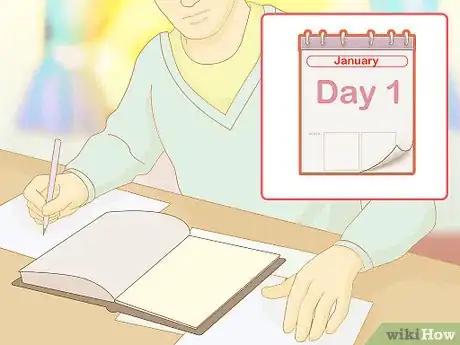
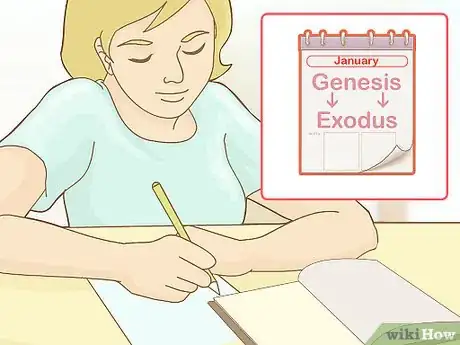
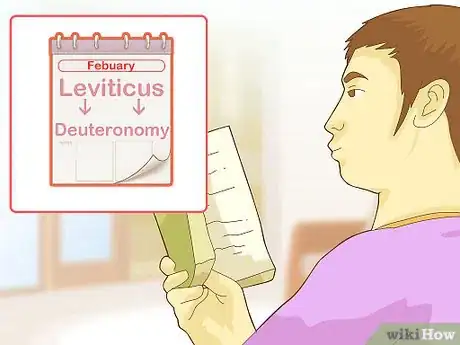

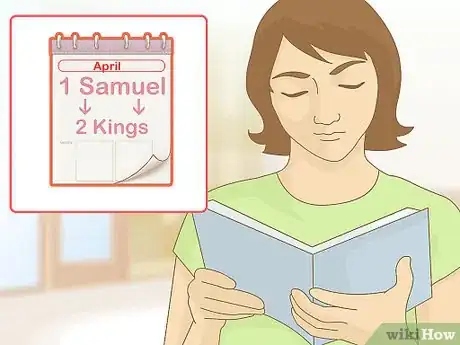


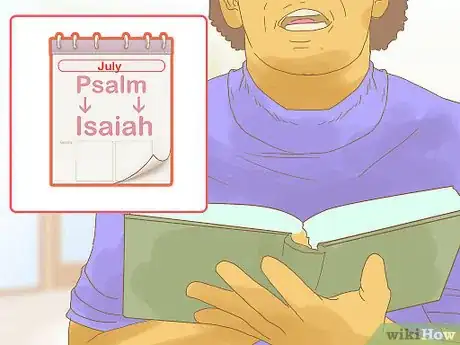


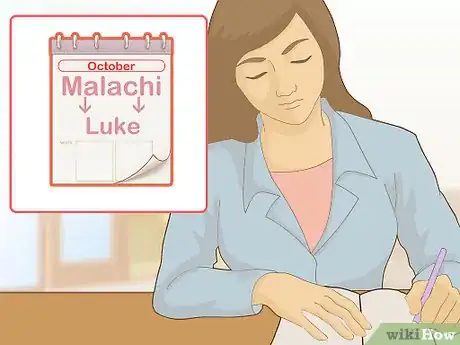
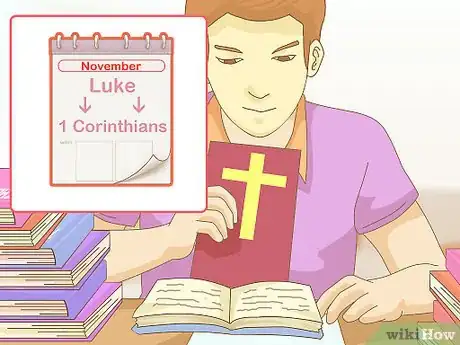



-Step-9.webp)























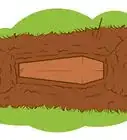
-Step-9.webp)



































